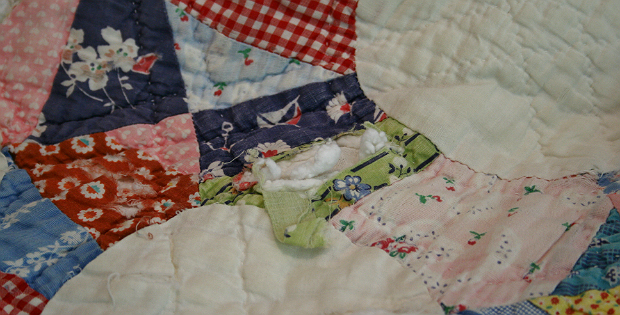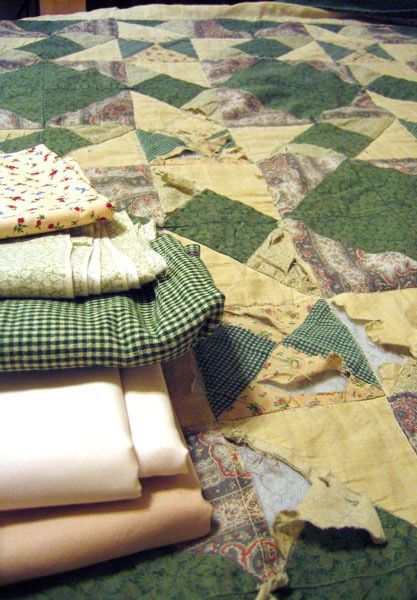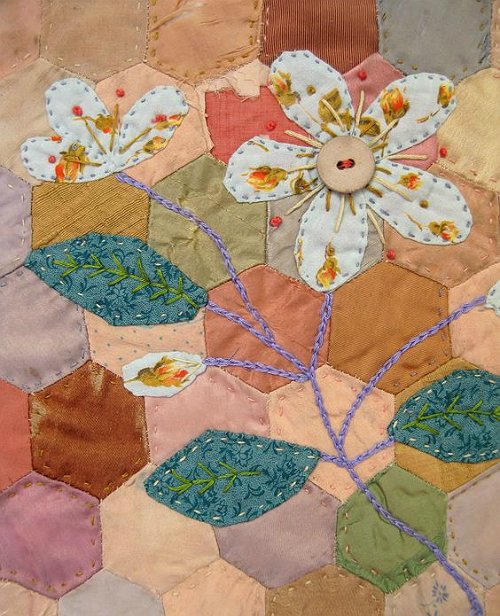How to Mend a Well-Loved Quilt

Whether Vintage or Newer, These Tips Will Help!
Unless you make quilts for show, chances are your quilts will be well used – and, over time they may need repairs. Old quilts that are passed down often need repairs as well.
Seams can come undone, fabric can fray, batting can become lumpy, and heaven forbid, chunks can go missing (like the corner that was chewed by a new puppy!).
Unless a quilt is totally filthy, wait until after repairs are completed before washing it, if it can be safely washed in the first place (dry cleaning is never a good idea because of the chemicals involved).
Repairs often require a bit of creativity, as well as care and attention to detail. For example if fabric needs to be replaced, match the old fabric as closely as possible, keeping in mind that it’s likely to have faded over the years. New fabric may stick out like a sore thumb, so choose carefully.
Also take into consideration any quilting that will need to be done once repairs are made. Try to match the thread color, stitch length and design with the new quilting. See an example here.
Treasured heirlooms may require conservation rather than standard repairs, so keep that in mind as well (more information later in this article). In general, if a quilt is in good shape overall (without brittle fabric or thread) it can usually be repaired.
Before beginning repairs, look the quilt over carefully and ensure that what you’re planning won’t adversely affect other areas of the quilt. Once repairs are completed, the quilt may not lay as flat or be quite as square, but an extended life is worth it.
Applique and embroidery covers a repaired area. Photo from Pinterest.
The following methods can be employed for repairing a quilt. Choose depending on what the quilt needs and how it will be used once it’s repaired. We recommend clicking through to the reference articles and considering all the options before choosing how to proceed.
- Repair Loose Seams – Turn under the seam allowances and hand stitch the folded edges together with an invisible stitch. Learn how here.
- Repair Torn Fabric – Bo-Nash Fusible Bonding Agent does a nice job. Learn more here.
- Replace the Fabric – Patches that are shredding can be covered with new fabric using the technique found here.
- Applique a Patch – Tears and shredded fabric can be covered with hand or machine appliqued patches, provided that fits with the nature of the quilt. See an example here.
- Replace the Batting and Binding – Old tied quilts may have batting that has shifted and become lumpy. If the quilt is otherwise sound, remove the binding, cut the ties and replace the batting. Re-tie or quilt it in whatever manner goes well with the top. See an example here.
- Resize the Quilt – If a corner is badly damaged you may need to cut the quilt down so that only the good part remains. Save any usable fabric for patches and other repairs. See an example here.
- Reproduce the Quilt – If all else fails, consider reproducing the quilt. While you probably won’t find the same fabric, it’s likely that you can recreate the look and feel with new fabric.
Antique heirloom quilts that are admired rather than used often should be conserved instead of simply repaired. Sometimes the best choice is to stabilize them to protect against further damage. While quilt conservation is outside the scope of this article, you’ll find good information here.
We recommend reading through this article before beginning repairs of any kind on an antique quilt. There are many excellent tips that will help you in restoring the quilt, as well as cleaning and washing guidelines.
Image Source: The photo at the top of the page is from Chic Tweaks.














Your comment about never drycleaning is okay unless you have a really old vintage quilt that has wool batting. That can’t be washed. It will shrink and completely destroy the quilt.